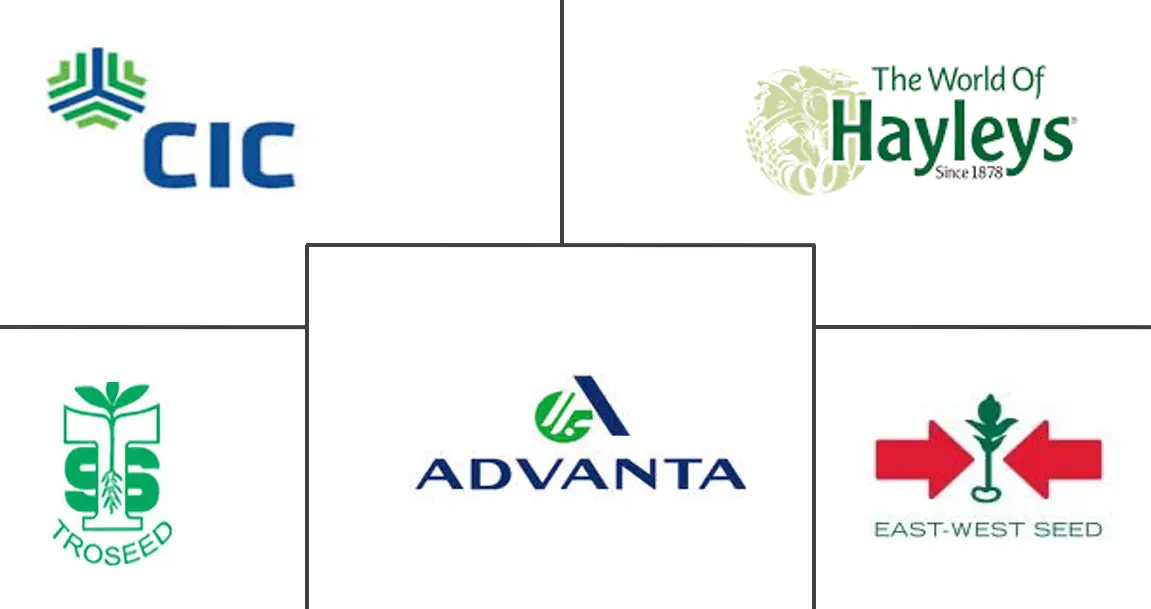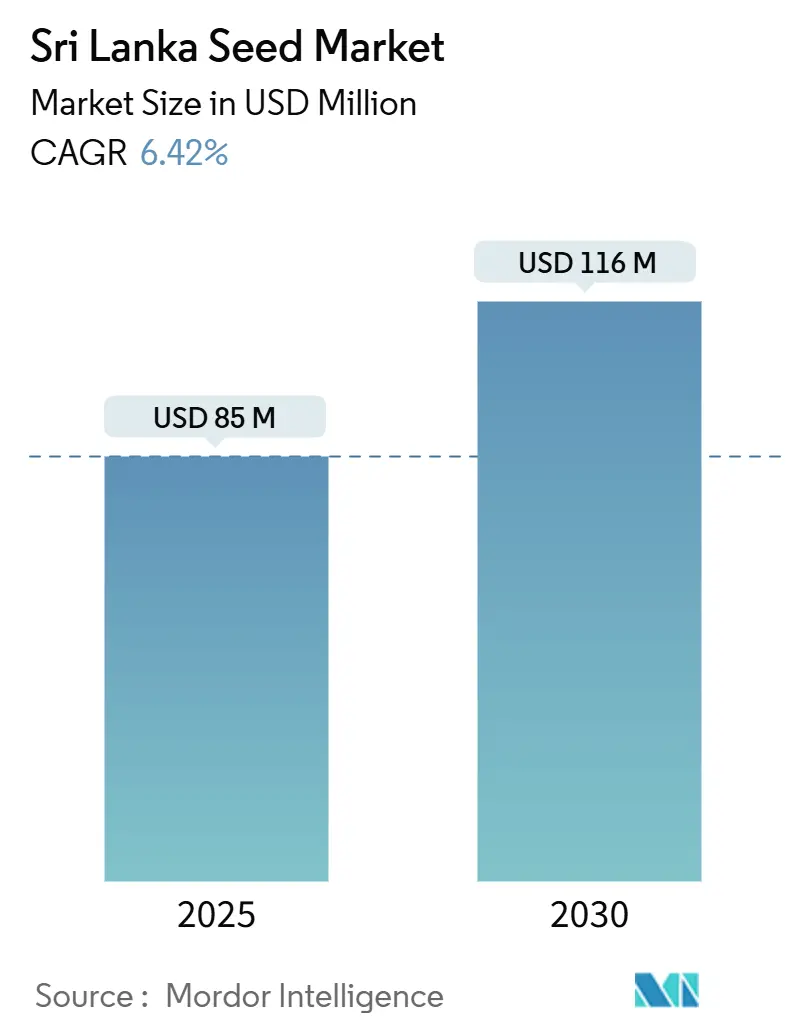
Sri Lanka Seed Market Analysis by Mordor Intelligence
The Sri Lanka seed market size stood at USD 85.0 million in 2025 and is forecast to reach USD 116.0 million by 2030, logging a 6.42% CAGR during the period. This growth trajectory reflects the country's strategic pivot toward agricultural modernization following the 2021 fertilizer crisis, which exposed critical vulnerabilities in the nation's food security infrastructure. The market's resilience stems from government-backed seed replacement programs and the agricultural sector's 2.6% positive growth in 2023 [1]Source: Ministry of Agriculture and Plantation Industries, agrimin.gov.lk.. Expansion of protected-cultivation acreage is raising demand for hybrid vegetable seeds, while climate-smart breeding programs are pushing adoption of high-yielding rice and maize cultivars. Import-dependent hybrid lines face currency-driven price swings, digital retail platforms, diaspora capital, and precision farming investments are widening last-mile distribution and improving quality traceability. Competitive intensity is moderate: the five largest firms command 65% of the Sri Lanka seed market, giving them scale advantages in procurement, R&D, and policy engagement.
Key Report Takeaways
- By product type, open-pollinated seeds commanded 58.0% of Sri Lanka seed market share in 2024, while hybrid seeds are projected to expand at a 9.2% CAGR through 2030.
- By crop type, grains, and cereals led with 45.0% of the Sri Lanka seed market size in 2024, whereas vegetables are forecast to grow at a 10.5% CAGR through 2030.
Sri Lanka Seed Market Trends and Insights
Drivers Impact Analysis
| Driver | (~) % Impact on CAGR Forecast | Geographic Relevance | Impact Timeline |
|---|---|---|---|
| Government seed-replacement subsidies for paddy farmers | +1.2% | North Central and Northwestern provinces | Medium term (2–4 years) |
| Expansion of protected-cultivation acreage boosting hybrid-vegetable demand | +0.9% | Western and Central provinces | Long term (≥ 4 years) |
| Rising adoption of high-yielding rice and maize cultivars to meet caloric needs | +0.8% | National drought-prone areas | Medium term (2–4 years) |
| Reinstated fertilizer subsidies improving farmer purchasing power | +0.7% | National smallholders | Short term (≤ 2 years) |
| Digital ag-retail platforms enabling last-mile seed distribution | +0.5% | Urban-adjacent areas expanding to remote villages | Long term (≥ 4 years) |
| Diaspora investment in specialty-seed export niches | +0.3% | Coastal regions and export-oriented agricultural zones | Long term (≥ 4 years) |
| Source: Mordor Intelligence | |||
Government Seed-Replacement Subsidies for Paddy Farmers
Government-backed seed replacement programs have fundamentally altered procurement dynamics by reducing the financial barrier between traditional farmer-saved seeds and certified varieties. Government funding narrows the price gap between farmer-saved and certified paddy seed, lifting certified-seed turnover and addressing the historical barrier where 67% of male growers favored traditional rice for cost reasons. Provincial distribution networks ensure quality oversight under the Sri Lanka Standards Institute. Experiential field comparisons accelerate voluntary adoption, creating a durable shift toward market-oriented seed selection. Sustained budget allocations and uninterrupted supply are vital to preserve farmer trust and keep the Sri Lankan seed market on its growth path. The program's success hinges on maintaining consistent funding allocation and preventing supply chain disruptions that could undermine farmer confidence in certified seed availability.
Expansion of Protected-Cultivation Acreage Boosting Hybrid-Vegetable Demand
The proliferation of net-houses and poly-tunnel structures is reshaping vegetable seed requirements by creating controlled environments that favor hybrid varieties over open-pollinated alternatives. Net-houses and poly-tunnels produce higher yields, stronger disease resistance, and larger crowns, making premium hybrids economically attractive in these environments. This technological shift necessitates seeds specifically bred for protected environments, where factors like light interception, humidity management, and space optimization become critical performance determinants. Younger, credit-ready farmers spearhead adoption, and IoT monitoring further amplifies returns, cementing hybrid vegetables as the fastest-growing component of the Sri Lanka seed market.
Rising Adoption of High-Yielding Rice and Maize Cultivars to Meet Caloric Needs
Climate variability has created urgent demand for rice and maize varieties that maintain stable yields under increasingly unpredictable weather patterns. The development of drought-tolerant varieties, such as Niyan Wee, which translates to "drought rice," demonstrates the focus of local breeding programs on resilience traits that traditional varieties cannot consistently deliver. Traditional varieties, while nutritionally superior and culturally valued, cannot match the yield consistency required for food security under current climate trajectories. With an annual per-capita rice intake of 107 kg, robust, high-yielding varieties are indispensable and drive the of Sri Lanka's seed market.
Reinstated Fertilizer Subsidies Improving Farmers' Purchasing Power
The restoration of fertilizer subsidies following the 2021 organic farming policy reversal has directly improved farmers' financial capacity to invest in quality seeds. Reversing the 2021 organic mandate, the government’s mixed 70% chemical and 30% organic approach raised paddy yields from a crisis-induced dip and unlocked cash flow for quality seed investments[2]Source: Organic Fertilizer Production Programme, csiap.lk.. A USD 483.5 million (LKR 150 billion) World Bank-backed compost program further cushions input costs. This dual-track approach ensures input security while gradually building organic production capacity.
Restraints Impact Analysis
| Restraint | (~) % Impact on CAGR Forecast | Geographic Relevance | Impact Timeline |
|---|---|---|---|
| High price of imported hybrid seed packets | -1.1% | Remote, lower-income districts | Medium term (2–4 years) |
| Counterfeit and uncertified seed circulation in informal channels | -0.8% | Rural areas with weak oversight | Short term (≤ 2 years) |
| Weak credit access for smallholders limits seed upgrades | -0.6% | Rural areas, particularly affecting smallholder farmers | Long term (≥ 4 years) |
| Shortage of breeder seed after 2021 fertilizer shock | -0.4% | National, affecting foundation seed production capacity | Medium term (2-4 years) |
| Source: Mordor Intelligence | |||
High Price of Imported Hybrid Seed Packets
Hybrid packets cost 2–3 times more than local open-pollinated lines, and currency swings can inflate retail prices by 20–30% per season. Import regulations governed by the National Plant Quarantine Service add compliance costs and processing delays that seed companies pass through to farmers via higher retail prices. Compliance costs under the National Plant Quarantine Service add delays and pass-through mark-ups [3].Source: SPS-TBT Enquiry Points, srilankatradeportal.gov.lk. Limited domestic R&D aggravates reliance on overseas genetics, restraining rapid hybrid uptake in the Sri Lanka seed market. Local breeding programs lack the research and development resources to match multinational corporations' innovation pace, perpetuating import dependency for cutting-edge traits like disease resistance and climate tolerance.
Counterfeit And Uncertified Seed Circulation In Informal Channels
Informal seed distribution channels circumvent quality control mechanisms, enabling counterfeit and uncertified seeds to reach farmers at attractive price points that legitimate suppliers cannot match. The Food Act No. 26 of 1980 provides a regulatory framework for seed quality, but enforcement capacity remains limited in remote agricultural areas where informal networks operate most extensively. The economic impact extends beyond immediate crop losses, as farmers who experience failures with counterfeit "hybrid" seeds may permanently revert to traditional varieties, slowing overall market development. Legitimate suppliers struggle to match the informal sector’s lower prices, dampening certified-seed penetration.
Segment Analysis
By Product: Open-Pollinated Dominance Faces Hybrid Pressure
Open-pollinated varieties held 58.0% of the Sri Lanka seed market share in 2024. Farmers favor open-pollinated seeds for seed-saving ease and lower up-front costs, preserving genetic diversity well-suited to local conditions. Transgenic hybrids, although still a niche, attract commercial growers seeking pest resistance and drought tolerance. Non-transgenic hybrids meet yield targets without navigating stringent GMO regulations, and vegetative hybrids serve premium fruit and ornamental niches.
While hybrids are forecast to grow at a 9.2% CAGR to 2030, hybrid gains accelerate in export-oriented vegetable farms and protected structures where consistent quality and uniformity justify premium seed prices. Large agribusinesses and contract farmers shift toward hybrids to satisfy supermarket and export standards, gradually eroding the historic dominance of open-pollinated lines in the Sri Lanka seed market. Syngenta’s 2024 decision to share CRISPR-Cas12a tools with academia signals an impending wave of next-gen cultivars that could further tilt this balance.
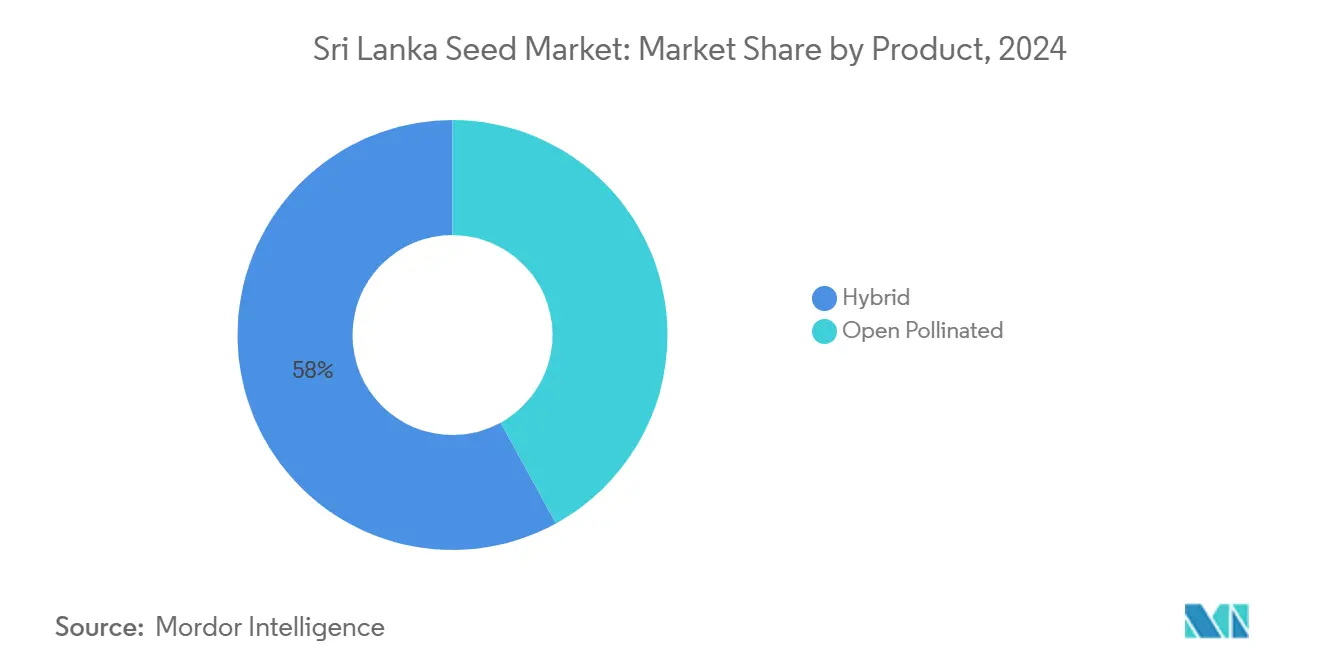
Note: Segment shares of all individual segments available upon report purchase
By Crop Type: Rice Foundation Supports Vegetable Diversification
Grains and Cereals accounted for 45.0% of Sri Lanka seed market size in 2024, underscoring the crop’s paramount food-security role. Government buffer-stock policies and salt-resistant breeding programs maintain steady demand, particularly across 223,000 ha of salinity-affected land. Maize hybrids targeting 8 metric tons/ha yields expand feed grain availability, while soybean remains small but poised for growth under import-substitution drives.
Vegetable segments demonstrate remarkable diversification, especially tomatoes under protected cultivation command rising attention, and hybrid vegetables exhibit the fastest CAGR at 10.5%. Pumpkin, gourds, chiles, and peppers thrive as high-value exports to Gulf markets. Oilseeds and pulses such as groundnut, mung bean, and cowpea suit crop-rotation systems, enhancing soil nitrogen and broadening revenue options. The Department of Agriculture’s multi-crop release pipeline, including MIBO 1 onion and ANK black horse gram, reinforces diversification momentum.
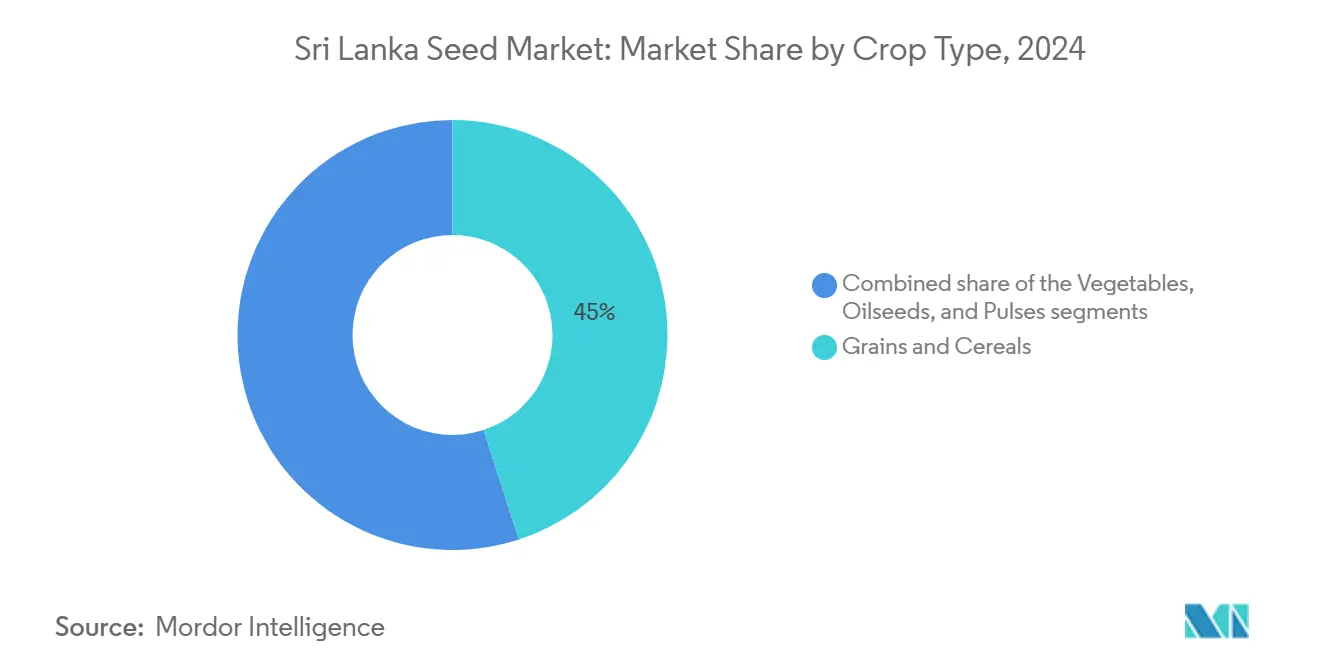
Note: Segment shares of all individual segments available upon report purchase
Geography Analysis
North Central and Northwestern provinces dominate rice cultivation, channeling subsidized certified-seed programs toward these regions. Paddy fields there rely on both drought-tolerant and salt-resistant varieties, ensuring stable output despite climate stress. The Western and Central provinces lead in protected-house vegetable production, where hybrid demand accelerates and digital retail adoption is strongest.
Dry-zone districts pursue water-efficient cereals and pulses, while wet-zone farmers focus on disease-resistant, high-humidity-tolerant cultivars. Coastal salinity zones test salt-tolerant rice and halophytic vegetable lines under the Katukurunda reclamation pilot, with 1,000 ha expansion planned within two years. Export-oriented clusters near Colombo Port choose short-duration, high-grade vegetable hybrids to meet shipping schedules and phytosanitary standards.
Urbanization draws labor away from upland districts, increasing interest in mechanization-friendly varieties and labor-saving agronomic packages. Diaspora-funded specialty-seed projects flourish along export logistics corridors, while digital-platform penetration varies by broadband availability. These regional nuances shape product portfolios, pricing, and marketing tactics for every participant in the Sri Lanka seed market.
Competitive Landscape
The Sri Lanka seed market is moderately consolidated, with the top five players including CIC Holdings PLC, Hayleys PLC, Troseed Pvt Ltd, UPL (Advanta Seeds), and East-West Seed Group B.V. Domestic incumbents anchor staple crops, whereas multinationals focus on premium hybrid solutions. Technology is the key differentiator. East-West Seed’s GrowHow digital platform reaches more than 41,000 tropical-region farmers, including a swelling Sri Lankan cohort, providing cultivation tips that bolster brand loyalty.
The moderately concentrated market structure allows for coordinated responses to policy changes and market disruptions. This was evident during the 2021 fertilizer crisis, when major companies collaborated with government agencies to ensure continuity in seed supply. Strategic trends indicate a dual focus, domestic companies emphasize staple crops and traditional varieties, while multinational corporations concentrate on high-value hybrid segments and specialty traits. Technology adoption has emerged as a significant differentiator, with companies like East-West Seed utilizing digital platforms and precision breeding techniques to strengthen their position in the expanding vegetable seed market.
Opportunities exist in organic-certified and climate-resilient product lines that are not adequately addressed by the current supply chain. Domestic companies benefit from their familiarity with local germplasm and regulatory flexibility but need to expand their research and development efforts to compete with the advanced breeding programs of multinational competitors. Ensuring quality assurance and monitoring informal distribution channels remain critical priorities to safeguard brand equity and sustain the growth of the Sri Lanka seed market.
Sri Lanka Seed Industry Leaders
-
CIC Holdings PLC
-
Hayleys PLC
-
Troseed Pvt Ltd
-
East-West Seed Group B.V
-
UPL (Advanta Seeds)
- *Disclaimer: Major Players sorted in no particular order
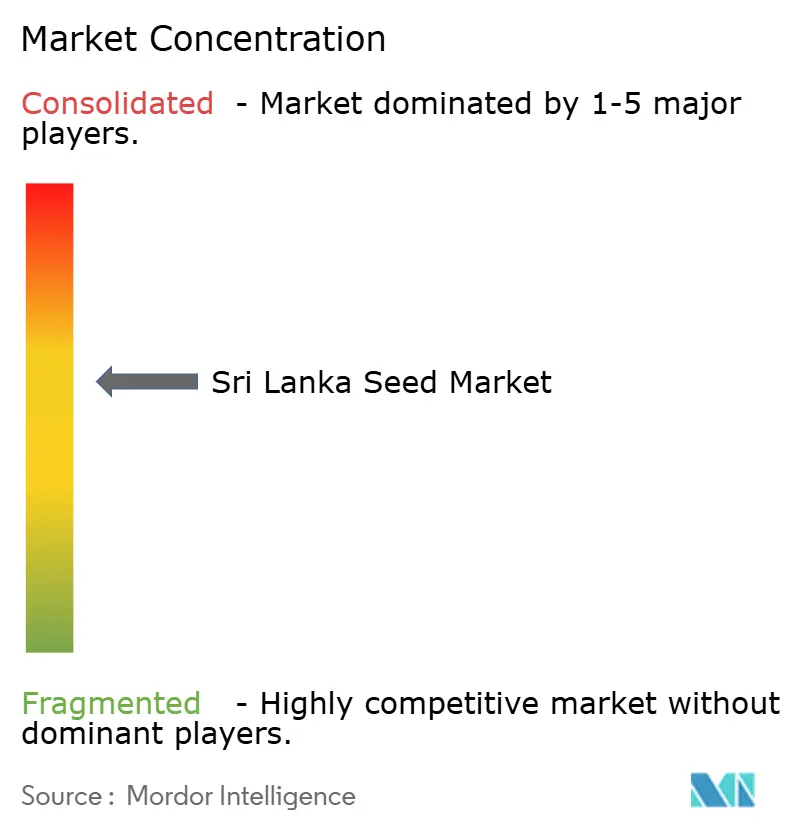
Recent Industry Developments
- March 2024: CIC Agribusiness has developed and launched five new hybrid vegetable seed varieties locally, in collaboration with an American company, from their seed farm in Pelwehera, Dambulla. This initiative aims to boost local agricultural productivity and reduce the foreign exchange spent on importing hybrid seeds. The project, costing over USD 800 million and spanning three years, helps to boost quality seed production to meet increasing demand.
- June 2024: Syngenta Group is providing rights to selected genome-editing and breeding technologies for academic research worldwide, including optimized CRISPR-Cas12a tools that could support agricultural research institutions in Sri Lanka.
- September 2022: Japan International Cooperation Agency (JICA) entered into a partnership with the United Nations Development Programme (UNDP) in Sri Lanka to procure 200 metric tons of maize seeds for the maha season.
Sri Lanka Seed Market Report Scope
A seed is the unit of reproduction of a flowering plant, capable of developing into another such plant. For the purpose of this report, the seeds used for sowing have been considered for market estimations and forecasts. The market does not include seeds used for human or animal consumption. The Sri Lanka Seed Market is Segmented by Product Type (Hybrid (Transgenic and Non-Transgenic) and Open Pollinated), Crop Type (Grains and Cereals (Rice, Maize, Soybean, and Other Crop Types), and Vegetables (Tomatoes, Pumpkin, Squash and Gourd, Chillies and Peppers and Other Vegetables). The report offers market estimation and forecast in value (USD million) and volume (Metric Ton) for the above-mentioned segments.
| Hybrid | Transgenic |
| Non-Transgenic | |
| Vegetative Hybrids | |
| Open Pollinated |
| Grains and Cereals | Rice |
| Maize | |
| Soybean | |
| Other Grains | |
| Vegetables | Tomatoes |
| Pumpkin, Squash and Gourd | |
| Chiles and Peppers | |
| Other Vegetables | |
| Oilseeds and Pulses | Groundnut |
| Mung Bean | |
| Cowpea | |
| Others |
| By Product | Hybrid | Transgenic |
| Non-Transgenic | ||
| Vegetative Hybrids | ||
| Open Pollinated | ||
| By Crop Type | Grains and Cereals | Rice |
| Maize | ||
| Soybean | ||
| Other Grains | ||
| Vegetables | Tomatoes | |
| Pumpkin, Squash and Gourd | ||
| Chiles and Peppers | ||
| Other Vegetables | ||
| Oilseeds and Pulses | Groundnut | |
| Mung Bean | ||
| Cowpea | ||
| Others | ||
Key Questions Answered in the Report
What is the current value of the Sri Lanka seed market?
The Sri Lanka seed market size is USD 85.0 million in 2025 and is projected to reach USD 116.0 million by 2030.
Which crop type segment dominates seed demand in Sri Lanka?
Grains and Cereals lead with a 45.0% share, driven by the crop's central role in national food security.
Why are hybrid vegetable seeds gaining traction?
Protected-cultivation structures and premium export prices make hybrid vegetables, the fastest-growing segment at a 10.5% CAGR, economically attractive.
What major restraint limits hybrid seed adoption?
Imported hybrid packets remain 2-3 times more expensive than local open-pollinated seeds, and currency fluctuations can inflate prices by up to 30%.
Page last updated on:
